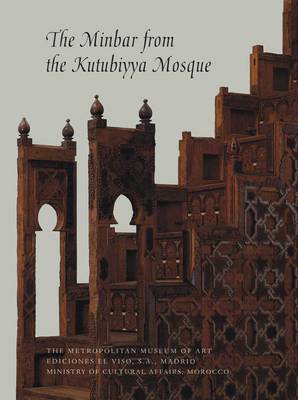One of the most accomplished works ever created by Islamic craftsmen, the minbar from the Kutubiyya mosque, Marrakesh, was begun about 1137 in Cordoba, a center of Andalusian arts and letters. This pulpit, which had been commissioned by the last Almoravid sultan, All ibn Yusuf, for his congregational mosque, soon became renowned throughout the western Islamic lands for its great artistry and beauty. It was so prized, in fact, that when the Almohads conquered Marrakesh in 1147 and destroyed 'All's mosque, they preserved the minbar for their new mosque. In 1381, an anonymous historian called it "a monumental minbar ... of perfect accomplishment," equaled only by the one in the Great Mosque of Cordoba (destroyed in the sixteenth century).
For more than eight hundred years, this work of supreme religious, historical, and artistic significance has remained a national treasure of Morocco. Its decorative scheme, which employs intricately carved wood panels and inlaid bone decoration covering every visible surface, is both traditional (in its reliance on previous examples) and startlingly original (in its sophisticated technique and vibrant rhythmic pattern). Its influence was felt for centuries, ultimately finding expression in the intarsia technique of Renaissance Italy, of which the Gubbio Studiolo at The Metropolitan Museum of Art, is an outstanding example.
This volume, the first comprehensive documentation of the minbar's structure, history, and artistic significance, derives from a joint conservation effort undertaken in the fall of 1996 by the Metropolitan Museum and the Ministry of Cultural Affairs of the Kingdom of Morocco. For nine months, a team of senior conservators from the Museum worked with their Moroccan colleagues on the delicate tasks of stabilizing, consolidating, and cleaning the minbar, with the aim of preserving it for posterity. In the process, several important discoveries were made, including an inscription giving new details about the commissioning of the minbar. Analyses conducted by the conservators also shed new light on the identification and dating of the materials used in the minbar. Now fully restored, the minbar is on permanent display in the Badic Palace in Marrakesh. Authors Jonathan M. Bloom and El Mostafa Hbibi provide a full discussion of the minbar's structure and decorative scheme. Exploring the work's art-historical significance, Stefano Carboni traces its roots back to the days of Muhammad and compares it to other important examples in the western Islamic lands. Ahmed Toufiq approaches the minbar as "the pulpit of an empire," imagining it in the days of its greatest glory. And the conservation team from the Metropolitan-Jack Soultanian, Antoine M. Wilmering, Mark D. Minor, and Andrew Zawacki-present a step-by-step account of their restoration efforts. These essays are supplemented by illustrations that document the minbar as never before. Large color images record every area of this masterwork, while details capture the carving and inlay in all their complexity. Specially commissioned drawings show the underlying structure of the minbar and the evolution of its decorative patterns. [This book was originally published in 1998 and has gone out of print. This edition is a print-on-demand version of the original book.]
- ISBN10 0300200250
- ISBN13 9780300200256
- Publish Date 10 September 2013
- Publish Status Cancelled
- Out of Print 6 July 2021
- Publish Country US
- Imprint Metropolitan Museum of Art
- Format Paperback (US Trade)
- Pages 124
- Language English
